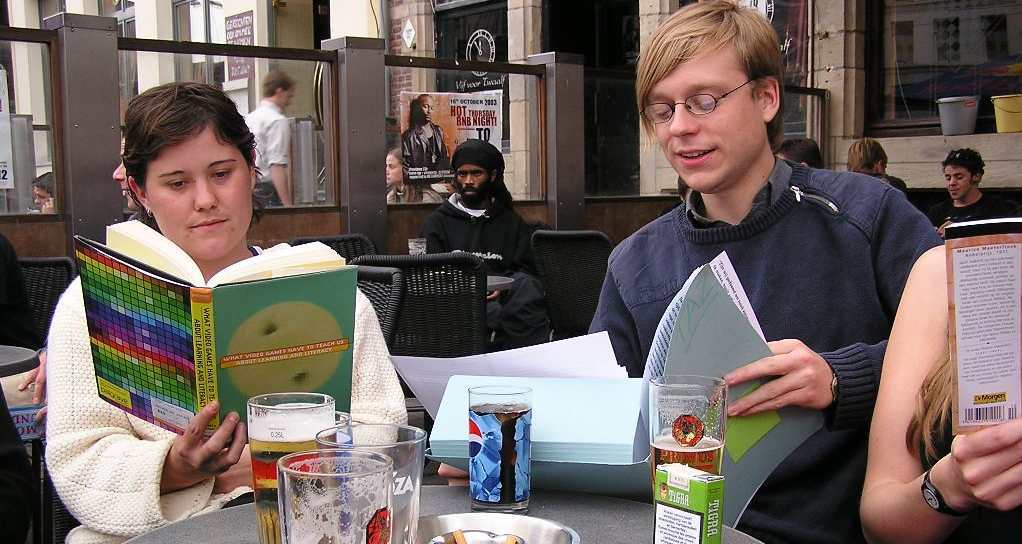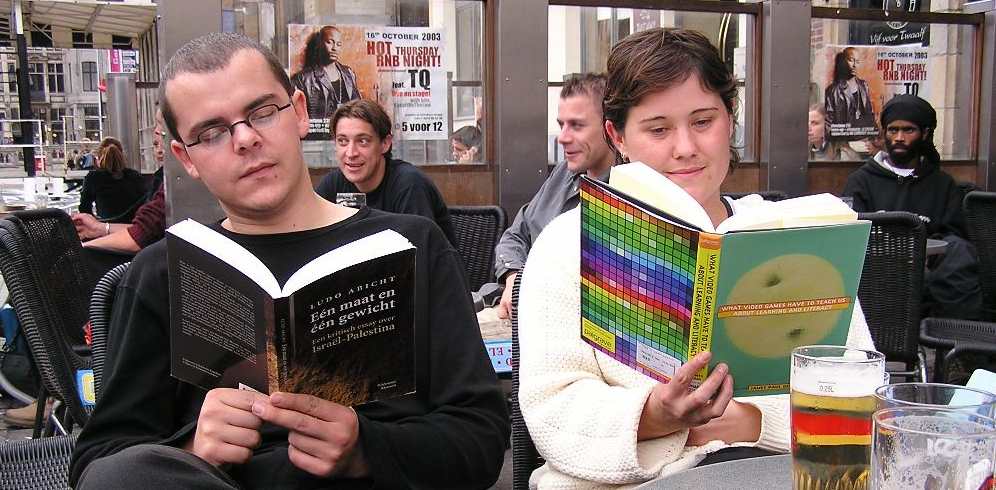This book explores digital literacy as embodiment of ideas, embodiment of text as
language and print matter, and theories about embodiment, using
the body as the representational surface in pictures for
characters in an alphabet book on digital literacy. Recent avant-garde experiments in
mixed-media book design reconfigure text and image. Tom Phillipís
Humument (1997), Willie Mastersí Lonesome Wife
(1968) by William Gass, Bonnie Gordonís Anatomy of Proteus
(1982) Cecelia Vicunaís Cloud Net (2001) and Aimť
Cťsaireís The Lost Body (1950), illustrated by Pablo
Picasso demonstrate new embodiments of text.
New research in philosophy considers the role of
visual and iconic matter in intellectual discourse. The
Philosophical Status of Diagrams by Mark Greaves (2002)
explores the reasons why structured graphics have been largely
excluded from contemporary formal theory systems.
His research finds an historic prejudice against diagrammatic
inference in logic and geometry and writing.

Several works influenced this new alphabet
project including Leo Stein's ABC of Aesthetics (1927) and Ezra Poundís
brief tour of poetics and literature, ABC
of Reading (1934).
The premise of alphabets as a primitive concept, provides a
historical context to understand literature and current literary
theory about embodiment as it relates to digital literacy . In the aftermath of modernism and the 1960ís new-wavism,
literary discourse pursued questions of embodiment. Other
influences include Johanna Druckerís research on typography and
alphabets, and George Bornsteinís and Theresa Tinkleís work on the
editorial theory about rendition of the textual body. Nicole
Brossardís sensual approach to literary essay provides another
perspective
on embodiment. New theorist of digital media such as Lev Manovich,
posit a new language of digital discourse, and others, such as
James OíDonnell propose that new media is derived from prior modes
of discourse.

Why an alphabet? Poundís ABC of Reading
and
Steinís The ABC of Aesthetics serve as loose departure points for this workís
construction. Like Poundís short tour of western cultureís
essential literary history, this alphabet is a tour of images from
western cultureís tradition of figurative art. Steinís theory of
"pictorial seeing" anticipates the study of cognition in relation
to knowledge. Alphabets as the primary element of a language are
encoded metaphor systems. The alphabet book format is generally
mixed media and offers freedom to experiment while
emphasizing the iconographic features of text. Carl Steadmanís
Kid A in Alphabetic Land - Lacan Trading Cards, (2000) a comic-book
introduction to Lacanian psychology is a contemporary example.
Adam Victor's Nouvel
ABECEDAIRE en Enigmes (1845) is a rare alphabet book
composed of large alphabet plates containing related
figures and a large
letter formed by something beginning with that
letter. Other examples are Russian designer
Hryhorij Narbut's Abetka
(1917) and Erte's Alphabet Series composed of human figures
begun in 1928 and printed in 1976.
In the early twentieth century--a period of
intense technological advancement-- there is an intense interest
in alphabets by avant-garde in a variety of
disciplines artists and writers. Perhaps the challenge of
change precipitates a cultural interest fundamental or
primitive concepts as represented by alphabets.
The Futurist Fillippo Marinettiís experimented in typography and
orthography calling for a revolution in visual, literary and
graphic expression with his "Technical Manifesto of Futurist
Literature"(1912-1914) and "Words in Liberty" (1919). The
Futurists principles of speed, sensation and action would
transform syntax using only infinitive verbs and nominative nouns,
replacing adjectives with analogies and discarding punctuation for
mathematical operators. The futuristís aesthetics sought to
streamline language and print for a more immediate signification
of meaning in reading and perception.
Another Futurist Francesco Cangiullo's
CaffŤ-Concerto - Alfabeto a sorpresa (Cafť-Chantant - Surprising
Alphabet 1916), creates words in different typefaces to form
images of landscapes, and human bodies. Surprise Alphabet
used analogy and metaphor in a hand scripted alphabet.
Marinetti's Dunes (1914) and Zang Thumb Tuuum (1914)
represented syntactical and typographic transformations
emphasizing the aural component of language on
the written page. Futurists aesthetics of speed and immediacy are
evident in the postmodern interest in hyper-text and
hyper-sensation and A New Alphabet acknowledges Marinettiís
influence in regard to current modes of digital text and graphic
production.
Walter Benjamin in 1935, considered the burgeoning accumulation
of artifacts of mass culture in his statement: "The mass is a
matrix from which all traditional behavior towards works of art
issues in a new form. Quantity has been transmuted into quality"
("The Work of Art in the Age of Mechanical Reproduction," XV). In
the twenty-first century, the internet has become
a democratic reservoir for digitized images of art, although efforts to
restrict usage and to sell viewing rights are underway. Several
repositories are now available for limited, shared public use.
This work explores ideas about the text and body, figuratively and
literally. Alphabets are the script of language and an analogy
between bones and letters is suggested. Text and alphabets are
written as pictorial and figurative objects to explore an
interaction with theories of embodiment and transition to new
modes of writing through digital technology. Paintings and photographs
of the body from the fine-art western tradition were selected as
the basic visual layer. The relationship of the body to text and
reading is most significant in emerging theories about the
biology of cognition and thought.
Fine Art images were chosen for their meaningful
visual value. Many of these images are well known visual icons
through reproduction as Leo Stein observed in his 1927
statement, "The world of art becomes a reinforcement of the
easy-chair. It is then essentially as important as the
easy-chair." (ABC of Aesthetics, 154). Much as Pound
promoted the idea that one must know certain literary works, this
book fosters knowledge of art, but not as Pound argues for an
essential knowledge of a literary or artistic cannon, but rather from
Steinís viewpoint of "fine art as social convention" (260). Fine
art images were placed for their potential allusive value and
juxtaposed to create new contexts. For instance, on page "H", Manetís nineteenth
century Olympia alludes to Titianís Venus Urbino (1583).
On the page "Reprise, John Alexander's Red Earth series
(2001) pays homage to Jasper Johns' Alphabet (1960) In this
book each page is a visual verbal poetic vignette of an individual
alphabet letter with an accompanying commentary. A particular artistís work may have been chosen
for its title, content, history or author name as a signifier for
the alphabet character.
Some pages were arranged to replicate the shape of the alphabet
character. Some letters have multiple pages, are omitted or are
placed in a different sequence. Several abecedarian poems were
composed using words of the base letter. Experiments in image
assemblage included; writing on the body and tattooing the figures
of painting and sculpture.
Computer based graphic design allows images and text to be
layered with variable states of transparency, cropping and
opacity. Graphic digital design software tools include: text
processing, page-composition, webpage html composition, paint
tools, photo-editing, animated imaging, slide-show editors, sound
production, mixing, sound compression, and video editing and
production. These tools/programs often use different protocols to
perform the same tasks on objects and layers. Product design
assumes an enclosed frame or viewing space in which the product
performs. This book was produced with the assumption of a paper
bound book viewing frame although it is also translated to HTML
for internet publication and browsing.
Printing is in black and white, although color printing would
be more effective for display of the paintings. Computer design
offers new possibilities with interesting limits. It is a language
of its own. Because one does not touch the material objects of
assembly, the process can feel like putting one's hands inside of
a black box, or like the nineteenth century photographer, working
in the dark under the camera cover. Images are retrieved and
handled by opening file spaces and moving the mouse or keyboard to
perform commands.
There is no paper, pen, paint, ink, brush, knife or glue.
Images and text matter are virtual objects viewed through the
screen. Tactile queues and physical techniques are diminished with
digital design resulting in increased use of mental resources and
memory to manage and control image storage and retrieval in
databases and image attributes of location, space, state and
description. The designer/writer/composer relies on software manipulation
to perform these tasks. Images and text as virtual
objects may be configured, stored and altered by several software
composition tools in order to obtain the appropriate feature set
for a particular design task. The manipulation and organization of
digital objects becomes embodied in a database or a virtual body
of concept constructions. Media scholar Lev Manovich and the
authors of "The Digital Manifesto" consider the aesthetics of
databases and their logic as the subject of new critique. The mode
of digital production is a new kind of literacy that constitutes
its own alphabet.